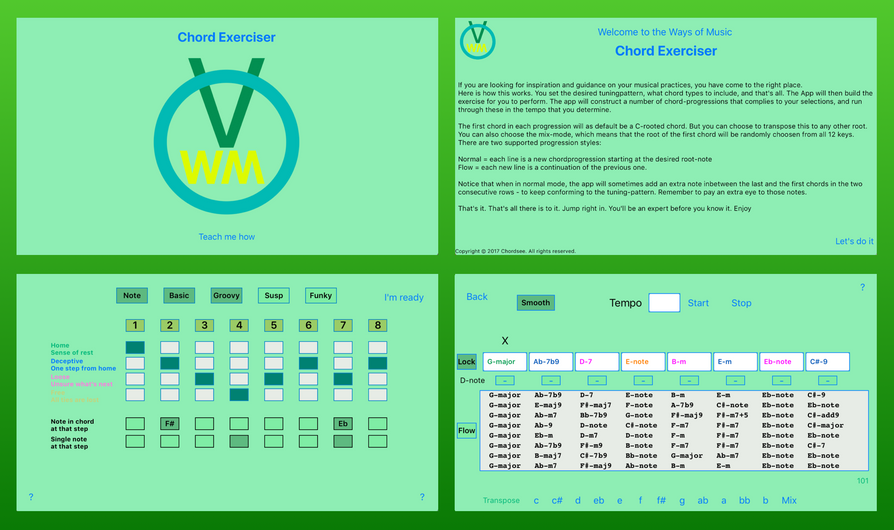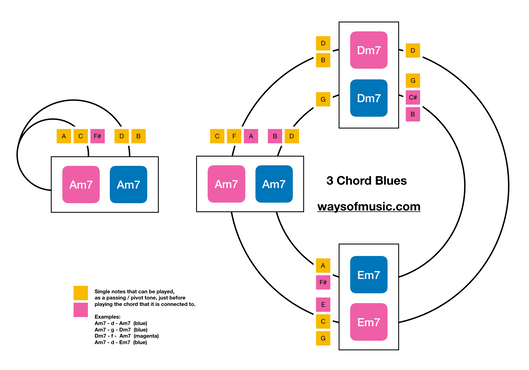
Ways of Music

3 chord Blues
3 chords is all it takes, to get a good thing going.
Follow the paths laid out here, and you will newer get astray.
If you need some additional improvisation and fillers between the chords, remember that the Pentatones are your best jamming buddies.
Have a look at my other article about the Pentatones, if you need to refresh what makes them so valuable.
Just pay attention to this; the last note you shall play - just before you play the chord (Am7, Dm7, Em7) - must be the note shown in the yellow and magenta squares, next to the chord. Otherwise, you’ll break the groove.
Grab you guitar or piano, and start improvising, you are set to go.

Backbone Blues
The Blues is in its core magenta. In particular the 12-bar Blues variant analyzed in this article.
To illustrate this, let's use the most basic 12-bar Blues we can think of, and a pattern I expect is known by all musicians, regardless of what instrument they play.:
C7 - C7 - C7 - C7
F7 - F7 - C7 - C7
G7 - F7 - C7 - C7
If you chose to play this chord progression as it is written above, the corresponding tension-colors would be as shown at the place of beat 1, across the 12 bars in the attached picture. To support the purpose of this article, the chord-progression is elaborated to a 4/4 timing representing this pattern:
C7 - x - C7 - x | C7 - x - C7 - x | C7 - x - C7 - x | C7 - x - C7 - X
F7 - x - F7 - x | F7 - x - F7 - X | C7 - x - C7 - x | C7 - x - C7 - X
G7 - x - G7 - x | F7 - x - F7 - X | C7 - x - C7 - x | C7 - x - C7 - X
To make it easy, let us say that the 2 and 4 beats are single notes. This means that all the ‘x’ will be replaced by single notes (like passing notes, pivot notes etc). The gray color is used here just as a placeholder, because depending on what note you play here, the resulting tension can be green, blue, magenta or yellow (if these color codes are new to you, please take a look at some of my other articles describing this).
Now to the fun stuff: notice the C7, F7 and G7’s; all but 3 are magenta. This is important to support and sustain when improvising in-between the 7th chords. Otherwise you will modulate the 12-bar Blues used here. Not that it's forbidden or wrong - it will just change the melody into something completely different.
This means that there are a limited number of notes you can chose from, when you improvise.
If you choose from these groups of notes - listed in increasing tension-order - you are on the safe side (the 7th chords will keep their magenta tension):
C7 - x - C7 : [f, ab, f#, a, c, eb]
F7 - x - F7 : [bb, c#, b, d, f, ab]
G7 - x - G7 : [c, eb, c#, e, g, bb]
Try it yourself, it’s very easy to hear that these progressions could go on and on and on - and that is because of the magenta tension = it never comes to rest.
With that trivia out of the way, let's have a look at the really useful knowledge that is the main story of this article. And that is how to support the chord changes C7 > F7 > C7 > G7 > F7 > C7 all while maintaining the 12-bar tension-colors, at the places they are show in the picture.
If X has to have magenta tension on its own - as indicated in the picture - then here are listed some of the valid chords to choose from (the number in parentheses are the total number of chords that will work, from a list of 23 different chord-types used in the analysis):
C7 - X - F7 (green) : Edim, Gsus2, Am7, D35, G25, … (31 in total)
F7 - X - C7 (magenta) : Fmajor, Dm, C35, Cadd9, … (37 in total)
C7 - X - G7 (magenta) : Edim, Am, C24, G24, … (37 in total)
G7 - X - F7 (blue) : Em, Asus2, Dsus2, D35, … (40 in total)
F7 - X - C7 (green) : Bdim, B24, Gmajor, D35, … (26 in total)
Notice why this is important: 23 chord-types in 12 keys, adds up to 276 different chords to choose from. BUT - as an example - in the case of the F7 > X > C7 (magenta) progression, there are 114 chords that will sustain a magenta tension of C7. But only 37 of these X-chords will have a magenta tension in the current context. And if you choose anyone of the remaining in the 114 group, the progression would start to sound very bumpy, and destroy the core fluidness that is also an important part of the perpetual modus of the 12-bar Blues.
About the chord notation used here - please see the explanation on the website.
Of cause, if the 7th chords were also allowed to be changed to other chord types, it would be even more interesting. But maybe we can get back to that some other time.
With all that said, you should be ready to rehearse and make Blues improvisations for many hours, without ever getting stuck in the same few motives.
